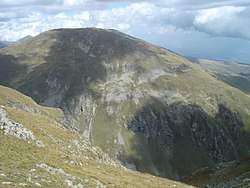Velika Rudoka
| Velika Rudoka | |
|---|---|
| Maja e Njeriut Rudoka e Madhe | |
 | |
| Highest point | |
| Elevation | 2,660 m (8,730 ft)[1][2][3] |
| Prominence | 230 m (750 ft)[4] |
| Isolation | 7.42 km (4.61 mi) → Titov Vrv[4] |
| Listing | Country high point |
| Coordinates | 41°55′6″N 20°46′35″E / 41.91833°N 20.77639°ECoordinates: 41°55′6″N 20°46′35″E / 41.91833°N 20.77639°E[4][5] |
| Geography | |
 Velika Rudoka Location | |
| Location | Kosovo |
| Parent range | Šar Mountains |
Velika Rudoka (Macedonian and Serbian Cyrillic: Велика Рудока; Albanian: Maja e Njeriut, Rudoka e Madhe) is the highest peak of the Rudoka Mountain, situated in the Šar Mountains range, exactly on the border between Kosovo[a] and North Macedonia.[6] With the altitude of 2,660 metres (8,727 feet),[1][2] it is the highest mountain of Kosovo and also the highest mountain of Serbia according to the view held by the government of Serbia. In some older sources, the altitude was stated to be 2,658 metres,[7][5][8] but newer measurements showed that the true altitude is 2 metres higher.[3]
The Rudoka Mountain is situated between Šar Planina and Vrace, southwest of Tetovo. The mountain range lies in a southwest to northeasterly direction, neighbouring Borislavec. The eastern slopes are very steep. The western slopes lightly descend into Šar Planina. Few waters are present on the mountain and there are few valleys. Two lakes are on Rudoka: Crno Jezero (Black Lake) and Belo Jezero (White Lake). The Mazdrača, a stream which flows into the Vardar, has its source in Crno Jezero. [9]
It is a common misconception that the highest mountain in Kosovo is Gjeravica at 2,656 m (8,714 ft). This was stated even in the 2020 Statistical Yearbook of Serbia,[10] and some Serbian schoolbooks.[3] The 2021 edition of the Statistical Yearbook of Serbia corrected the info,[1] naming Velika Rudoka the highest peak, as did the 2021 edition of the Geography schoolbook for Serbian elementary schools.[2] The 2021 edition of the Statistical Yearbook of Kosovo still states that Gjeravica is the highest mountain.[11]
It has been known that Velika Rudoka is the higher of the two mountains since at least 1972, when the Topographical Map of Yugoslavia was published. According to Sava Stanković, PhD, the misconception started because of unclear boundaries between the Socialist Republic of Macedonia and the Socialist Republic of Serbia. The border was conclusively determined only after the breakup of Yugoslavia by a treaty[12] between the Federal Republic of Yugoslavia and the Republic of Macedonia signed in Skopje on 23 February 2001.[3][13]
Notes[]
| a. | ^ Kosovo is the subject of a territorial dispute between the Republic of Kosovo and the Republic of Serbia. The Republic of Kosovo unilaterally declared independence on 17 February 2008. Serbia continues to claim it as a part of its own sovereign territory. The two governments began to normalise relations in 2013, as part of the 2013 Brussels Agreement. Kosovo is currently recognised as an independent state by 97 out of the 193 United Nations member states. In total, 112 UN member states have recognised Kosovo at some point, of which 15 states later withdrew their recognition. |
References[]
- ^ a b c "Статистички годишњак Републике Србије, 2021". Statistical Office of the Republic of Serbia. 20 October 2021. p. 15. Retrieved 1 January 2022.
- ^ a b c Bubalo Živković, Milka (2021). Географија за 8. разред основне школе. Belgrade: Завод за уџбенике. p. 28. ISBN 978-86-17-20527-8.
- ^ a b c d Vojinović, Miloš (24 June 2021). "Setiti se Šar planine: Najviši vrh Srbije nije onaj o kome se uči u školi". Radio Televizija Srbije. Archived from the original on 15 October 2021. Retrieved 26 December 2021.
- ^ a b c "Velika Rudoka". Peakbagger.com. Archived from the original on 12 January 2021. Retrieved 12 January 2021.
- ^ a b "Great Rudoka, 2658m". Summit Post. 28 October 2018. Archived from the original on 28 October 2018. Retrieved 11 January 2021.
- ^ From the Border Treaty signed between FR Yugoslavia and R Macedonia in 2001: [...] гранична линија се протеже општим правц��м према североистоку, правом линијом, до врха на гребену Рудока, на око 80 m источно од ТТ к. 2629, наставља гребеном преко к. 2630 до ТТ к. 2658, где мења општи правац [...]
- ^ "Topografska karta Gostivar 730-2-1 Titov Vrv". Topografska Karta JNA 1:25000. Vojnogeografski institut. 1973. Archived from the original on 11 December 2021. Retrieved 11 December 2021.
- ^ "(Foto) Upoznajte Srbiju: Otkrivamo nedoumice, koji je najviši vrh naše zemlje?". NS Uživo. 27 July 2020. Archived from the original on 12 January 2021. Retrieved 12 January 2021.
- ^ Narodna enciklopedija srpsko-hrvatska-slovenačka III knjiga. Bibliografski zavod D.D. Zagreb. 1928. p. 983.
- ^ "Статистички годишњак Републике Србије, 2020". Statistical Office of the Republic of Serbia. 20 October 2020. p. 15. Retrieved 1 January 2022.
- ^ Vjetari Statistikor i Republikës së Kosovës, 2021 (in Albanian). Agjencia e Statistikës së Kosovës (Kosovo Agency of Statistics). 2021. p. 26. ISBN 978-9951-22-727-8. Archived from the original on 1 January 2022.
- ^ "Закон о потврђовању уговора између Савезне Републике Југославије и Републике Македоније о протезању и опису државне границе" (in Serbian). Службени лист Савезне Републике Југославије - Међународни уговори. 11 May 2001. pp. 27–32. Retrieved 30 December 2021.
- ^ "Najviši vrh u Srbiji – Nije onaj na koji ste prvo pomislili". Srbija Pod Lupom. 24 August 2021. Retrieved 26 December 2021.
{{cite web}}: CS1 maint: url-status (link)
External links[]
| Wikimedia Commons has media related to Velika Rudoka. |
- Mountains of Kosovo
- Mountains of Serbia
- Two-thousanders of Kosovo
- Two-thousanders of Serbia
- Highest points of countries
- Šar Mountains


